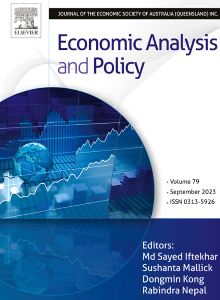碳偏技术进步对区域可持续发展的影响及机制
IF 8.7
2区 经济学
Q1 ECONOMICS
引用次数: 0
摘要
目前,经济和社会的可持续转型是最关键的全球问题之一。因此,研究技术发展趋势对可持续发展的实际影响以及渠道的作用具有重要意义。本文通过将劳动力、资本和碳资源加入先验对数随机前沿生产函数,对2010 - 2021年中国30个省区的要素偏倚技术进步指数进行了检验。我们建立了一个空间德宾模型。结果如下:(1) 2010-2021年中国总体技术进步偏向劳动力利用、资本利用和碳节约,且劳动力利用和碳节约的偏倚程度较高。(2)东、东北、中、西部地区技术进步先后实现了从利用碳到节约碳的转变。(3)碳偏技术进步对区域可持续发展具有双重影响,两者的平衡决定了区域可持续发展水平的整体影响。(4)有利于劳动力和碳排放的技术进步通过提升人力资本促进区域可持续发展,而有利于资本和碳排放的技术进步会增加能源强度,阻碍区域可持续发展。(5)偏向性技术进步对可持续发展的影响受到环境规制的正向调节,但存在负向空间溢出效应。因此,亟需制定差别化的低碳技术进步政策,加大对绿色创新的培训和激励力度,修订合理的节能环保法规,为可持续发展绘制坚实的蓝图。本文章由计算机程序翻译,如有差异,请以英文原文为准。
The impact and mechanism of carbon-biased technological advancement on regional sustainable development
Presently, the sustainable transformation of economies and societies is among the most crucial global issues. Thus, it is important to study the actual effects of technological-development trends on sustainable development (SD) and the role of channels. This study examines the factor-biased technical-advancement index of 30 Chinese provinces from 2010 to 2021 by adding labor, capital, and carbon resources to the transcendental logarithmic stochastic-frontier production function. We build a spatial Durbin model. The results are as follows. (1) China’s overall technological advancement in 2010–2021 favors labor use, capital use, and carbon saving, with there being a higher degree of bias toward labor use and carbon savings. (2) Technological advancement in eastern, northeastern, central, and western China has successively transformed from carbon use to carbon saving. (3) Carbon-biased technological advancement has a dual effect on regional SD, and the balance between these two impacts determines the overall effect of the SD level. (4) Technological advancements that favor labor and carbon can promote regional SD by elevating human capital, but technological advancements favored capital and carbon can increase energy intensity and obstruct SD. (5) The influence of biased technological advancement on SD is positively moderated by environmental regulation, but there are negative spatial spillovers. Thus, it is urgent to formulate differentiated policies on low-carbon technological advancement, increase the training and incentives for green innovation, and revise reasonable energy-saving and environmental-protection regulations to achieve a solid blueprint for SD.
求助全文
通过发布文献求助,成功后即可免费获取论文全文。
去求助
来源期刊

Economic Analysis and Policy
ECONOMICS-
CiteScore
9.80
自引率
9.20%
发文量
231
审稿时长
93 days
期刊介绍:
Economic Analysis and Policy (established 1970) publishes articles from all branches of economics with a particular focus on research, theoretical and applied, which has strong policy relevance. The journal also publishes survey articles and empirical replications on key policy issues. Authors are expected to highlight the main insights in a non-technical introduction and in the conclusion.
 求助内容:
求助内容: 应助结果提醒方式:
应助结果提醒方式:


